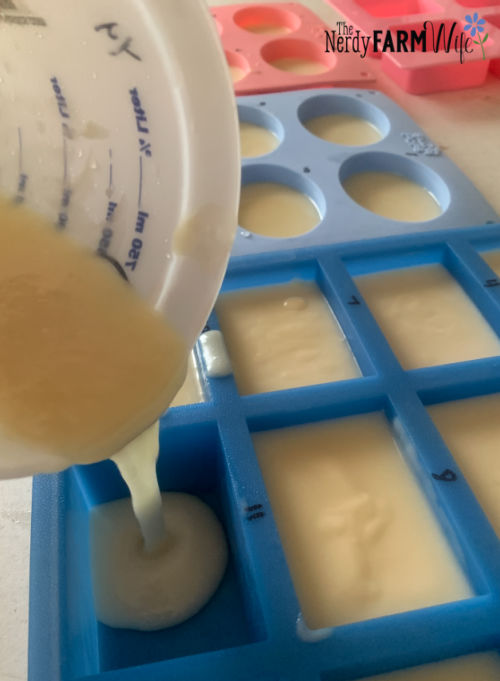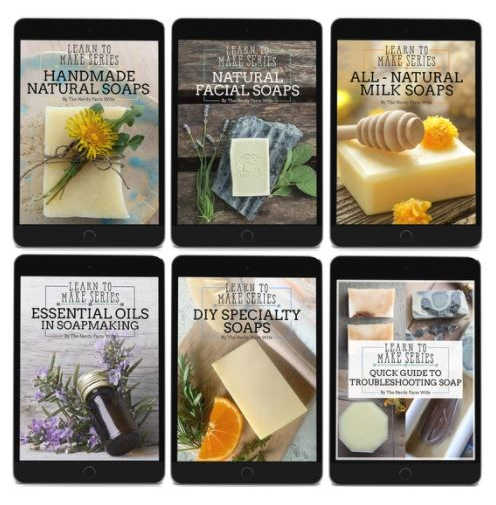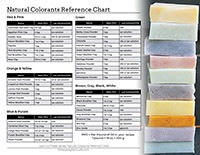Alternatives to Silk Fiber in Soap {an experiment}
Can you add different kinds of fibers, such as alpaca, cashmere, and bamboo silk to soap? I try those fibers and more in this cold process soap experiment!

Several months ago, my daughter (an avid fiber/spinning enthusiast) saw me adding some Tussah silk fiber to soap, and wondered if other types of fiber could be used in handmade soap instead.
I hadn’t thought of that, but my curiosity was piqued!
She was specifically wondering about making cashmere soap or rose fiber soap, but I thought I’d test out every kind of fiber I could get my hands on.
These are the results of the first part of my experiment, testing 3 plant-based fibers and 7 animal fibers, plus a control bar with silk as a comparison.
Part two of this experiment will test more plant-based fibers (and there may be a part three), but first I need to make those soaps and let them cure for several months to observe.
Main Takeaways
You can see more in the chart below, but the main lessons I took away from this experiment are:
- It’s important to strain the lye solution, even if the fiber looks like it’s dissolved. Unstrained solutions tend to leave yellow spots in the soap. (But most don’t appear to be DOS – dreaded orange spots of rancidity – these were more reminiscent of scorched bits of milk in soap.)
- Most of the soaps had a wonderful feel to the lather, but it’s hard to top the luxury of Silk Fiber in a soap. There was clearly something extra special about the soap made with Silk, though Cashmere was really close too! (Cashmere soap is definitely on my recipes-to-make list now.)
- The animal fibers tested all had some level of silky feel. I would enjoy using a soap made with any of them.
- For the plant-based fibers: Bamboo Top had a slightly nicer feel than Seacell Top and Pineapple Top, but nothing really impressive – and those last two just felt like regular soap. They may be good for label appeal, but unsure about actual benefits. More plant-based fiber experiments are in the cards for sure.
- Common sense with allergens applies – label and disclose if you use an animal fiber in soap. I’m pretty sensitive to animal fur (my cats, dogs, goats, make me itchy when I pet them unless I wash my arms and hands immediately after), and none of these soaps bothered me. But certainly, there’s a potential.

11 Fibers to Try in Soap (an experiment)
Here are the results from part one of my Fibers in Soap Experiment. In hindsight, I should’ve strained every one of the lye solutions through an even finer stainless steel mesh sieve than I used. I believe the yellow spots are related to my subpar straining efforts. ?
| Fiber Type | Dissolves well? | Yellow spots? | Feel | Did I strain? | Notes |
| Cashmere | fairly well | three | excellent | yes | undissolved bits turned yellow |
| Baby Camel | not well | two | very nice | yes | made brown flecks in lye solution |
| Angora | not well | one | very nice | yes | white flecks in yellow lye solution |
| Baby Alpaca | fairly well | several | very nice | no | turns lye light yellow, I should’ve strained |
| Yak | not well | none | very nice | yes | brown flecks, light tan lye solution |
| Baby Llama | not well | two | very nice | yes | brown flecks, light tan lye solution |
| Kid Mohair | fairly well | one | very nice | no | light ash on cured soap |
| Bamboo | very well | several | nice-ish | no | very light ash |
| Silk | fairly well | two | excellent | no | classic touch of luxury |
| Seacell | not completely | multiple | normal | no | only bar to smell “off”, may be going rancid |
| Pineapple | not completely | none | normal | no | no negative issues |
Fibers Source
These are the fibers I purchased for my experiments:
Plant Based Fiber Top Sampler Pack, Vegan (Etsy)
Luxury Spinning Fiber Assortment, Animal (Etsy)
and my daughter is contributing a few pinches from her ever-growing stash. (She buys primarily from Etsy too.)
My Test Recipe
This is the recipe I used to make the test batches.
- 2 oz (57g) olive oil (50%)
- 1.25 oz (35 g) coconut oil (31%)
- 0.25 oz (7 g) castor oil (6%)
- 0.5 oz (14 g) refined shea butter (13%)
- 1.13 oz (32 g) distilled water (2:1 water:lye)
- 0.57 oz (16 g) lye (5% superfat)
- abt 1/4 tsp fiber, snipped into fine pieces, stirred into hot lye solution
Many soapmakers enjoy felting their soaps with various types of roving, so this experiment seems to indicate that you could potentially include a bit of fiber inside the soap for added label appeal and extra silky feel. It’s certainly not for everyone, but may be a fun idea for some to experiment with further. ?

You may also enjoy my Handmade Natural Soaps eBook Collection. It contains:
- Handmade Natural Soaps eBook
- Natural Facial Soaps eBook
- All-Natural Milk Soaps eBook
- DIY Specialty Soaps eBook
- Essential Oils In Soapmaking eBook
- Quick Guide to Troubleshooting eBook
- Printable Soap Additives Chart
- Printable Essential Oils for Soapmaking Chart
- Soapmaking Checklist to Keep You Organized
- Reference List of Soapmaking Abbreviations
- Helpful List of Soap Supplies & Resources



hi , have you tried natural cotton fibers ?
DLF
Hi! I sure haven’t tried that one in soap yet. It’s in my pile of fiber though! :)
It’s September, and that means it’s milkweed fluff season in southern Vermont. I found myself wondering about adding milkweed fluff in soap, and some Googling led me here. Any plans to test it, or should I do so and report back? =D
Hi Erin, What a unique idea to try! That’s something I haven’t thought of before. I don’t have any soapmaking plans in the near future (too many other projects in the works!) :) so if you give it a try, I’d love to hear how it goes!
Thank you for this! I’m very interested in all of your unique soap experiments and trials–so many of them are things I wish I had the time to do, so I read with great interest! I especially enjoy your charts and graphs–makes your discoveries so easy to share and decipher.
I currently only use silk in (only) one of the many different soaps I make. But I agree with you–it’s WONDERFUL! I, too, am interested in using the milk weed fibers–I hadn’t thought of that before. I hope Jan will try it and let us know!
Hi Liz! I’m so glad you enjoy reading about the soap experiments! I’m still curious about the milkweed too.
We’re planting a couple of big milkweed/butterfly patches this fall for next year’s blooms, so hope to have some materials to give that a try too! ?
I hope “Erin” will try it, I should have said!
This is very interesting! I wonder if cotton fiber would require a different method for dissolving it than silk and wool do since it is cellulose rather than protein-based. I’ve read that bases like lye (and I think strong salts as well) easily break down protein based fibers like silk, wool, hair whereas acidic environments preserve them (like in peat bogs). But that it’s the opposite for cellulose-based fibers like cotton, linen, rayon, paper – that they are easily degraded by acids, and preserved in more basic solutions/ environments. (Reason why acid-free paper lasts forever, but cheap paper manufactured with acids will turn yellow, brittle, and fall apart in a few years.) But probably lye is corrosive enough that it would even break down cellulose? Seems unlikely that it could ‘preserve’ it!
That is very interesting information – thanks for sharing your thoughts Ingrid!
There’s a lot to explore with this topic; I still haven’t had the chance to return to it yet, but hopefully one day! :)
I wonder how corn silk would work…
Hi Bobbi, Corn silk works great in soap! Use it in a tea like other herbs and use that tea for the lye solution.
I make a sunflower & corn silk soap – the recipe is in my print book (Simple & Natural Soapmaking), but all you have to do is make a tea of sunflower petals and corn silk and use it in your favorite soap recipe.
I also add 1/2 tsp annatto seed powder to the hot lye solution, to give the soap a pretty yellow color. (Strain the lye solution to minimize speckles.)